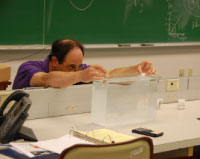 |
|
|
| SEARCH | LABORATORY ACTIVITIES | |||||||||||||||||||||||||||||||||||||||||||||||||||||
|
The activities presented during this workshop followed the format we use in our college-level classes, which are composed mostly of sophomore, junior, and senior science and education majors who have previously taken an introductory oceanography course. Graduate students and our colleagues have found some of these activities challenging. For other settings (e.g., students with different backgrounds) and other curricula, these activities can and should be adapted, with appropriate changes in class discussions, activity descriptions, and explanations, along with the addition of background material (for background information, please see our publication Teaching Physical Concepts in Oceanography). Science teachers who participated in this workshop have successfully adapted some of the activities to their middle and high school classes. In our workshops, the activities are most often conducted at stations through which teams of three or four members rotate. At times, we present them as a sequence of activities or demonstrations that our workshop participants follow collectively, with members seated in small groups to facilitate discussion. Working in small groups fosters collaborative thinking and learning. Often we encourage a healthy competition among groups (e.g., with group quizzes) to add a level of excitement and challenge. Once an activity is completed, the participants gather for a summary discussion during which each group is asked to offer an explanation for a given activity. A 90-minute period is usually sufficient to complete four to six activities during the first hour, leaving approximately 30 minutes for group discussion. Note that each activity can stand alone or can be presented as a class demonstration. Most require simple and affordable equipment that is generally available in classrooms or homes. We purchased some equipment at specialized science educations stores (e.g., sciencekit.com) and we constructed some equipment ourselves. Videos Chapter 1 Density Activity 1.4 Density Flows: Flash Video | QuickTime Movie
Chapter 2 Pressure
Activity 1.5 Effect of Stratification on Mixing: Flash Video | QuickTime Movie Activity 2.1 Bed of Nails: Flash Video | QuickTime Movie
Chapter 3 Buoyancy
Activity 2.3 Ready, Set, Squirt (Hydrostatic Pressure): Flash Video | QuickTime Movie Activity 2.6 Compressibility of Gases (Boyle's Law): Flash Video | QuickTime Movie Activity 3.1 Mayday! (Archimedes Principle): Flash Video | QuickTime Movie
Chapter 4 Heat and Temperature
Activity 3.2 Archimedes Ball (Diving Ball): Flash Video | QuickTime Movie Activity 3.4 Cartesian Diver: Flash Video | QuickTime Movie Activity 3.5 Lake Levels: Flash Video | QuickTime Movie Activity 4.3 Natural Heat Convection: Flash Video | QuickTime Movie
Chapter 5 Gravity Waves
Activity 4.5 Heat Flow and Latent Heat: Flash Video | QuickTime Movie Activity 4.8 Reversing Density Rods: Flash Video | QuickTime Movie Activity 5.1 Wave Speed and Water Depth (Shallow Water Waves): Flash Video | QuickTime Movie
Lab contact: Lee Karp-Boss
Activity 5.2 Internal Waves: Flash Video | QuickTime Movie Activity 5.3 Buoyancy Oscillations: Flash Video | QuickTime Movie |
|||||||||||||||||||||||||||||||||||||||||||||||||||||
|
|||||||||||||||||





